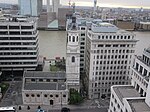Fishmongers' Hall
1834 establishments in EnglandAC with 0 elementsBuildings and structures completed in 1834Buildings and structures on the River ThamesGrade II* listed buildings in the City of London ... and 3 more
Grade II* listed livery hallsLivery hallsUse British English from October 2020

Fishmongers' Hall (sometimes shortened in common parlance to Fish Hall) is a Grade II* listed building adjacent to London Bridge. It is the headquarters of the Worshipful Company of Fishmongers, one of the 110 livery companies of the City of London. The Hall is situated in Bridge Ward.
Excerpt from the Wikipedia article Fishmongers' Hall (License: CC BY-SA 3.0, Authors, Images).Fishmongers' Hall
Upper Thames Street, City of London
Geographical coordinates (GPS) Address External links Nearby Places Show on map
Geographical coordinates (GPS)
| Latitude | Longitude |
|---|---|
| N 51.50939 ° | E -0.08764 ° |
Address
Fishmongers' Hall
Upper Thames Street
EC4R 3TJ City of London
England, United Kingdom
Open on Google Maps











